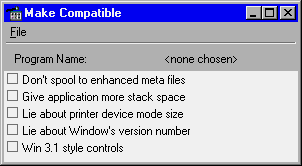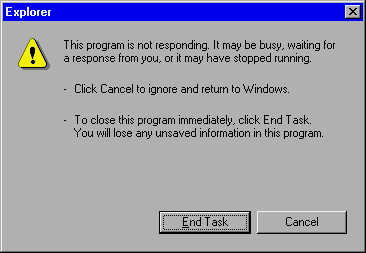|
This is a continuation of Advanced Tips and Tricks, Part 1, with many more "must-know" tidbits. Many of these tips are undocumented, but we think you'll find them useful nonetheless.
Tame those finicky 16-bit Windows apps Tame those finicky 16-bit Windows appsIn the \Windows\System folder is a program called MKCOMPAT.EXE that lets you change the settings to try to make a poorly behaved Windows 3.x program compatible with Windows 95. Go to the RUN line on the Start button and enter MKCOMPAT, which should give you the dialog box shown below. This utility even includes an Advanced option under the File menu.
Sign here... Auto-Sigs in ExchangeWhen using Microsoft Exchange with Word Mail running (Word Mail is included with Microsoft Office 95), an easy way to put a signature into your mail is to use the AutoText option. Create your signature, highlight it, select AutoText from the Edit menu and drop it in. When you want to use it, type in the first few letters, hit F3, and your signature will be added to your e-mail. Rapid-growth Explorer treesTo quickly expand the Explorer tree view to show all subfolders of a highlighted drive or folder, press the asterisk key (*) on the numeric keypad. Make your own Start Menu EditorA handy Edit Start Menu shortcut: You could simply drag a shortcut in the Start Menu folder to the desktop, but that's not quite adequate. Try this instead: Right-click on the Desktop and select New|Shortcut. Enter the following (all on one line) on the command line: C:\windows\explorer.exe /e, /root, C:\windows\start menu. Change the icon to one of your choice. I'm partial to that little Windows 95 flag icon contained in \windows\system\shell32.dll. Why limit yourself to one Explorer?The default Explorer icon opens C:\, listing everything on that drive. That's all well and good, but what if you want to look at drive D or E or your CD-ROM drive? No need to browse through the default view--just create another Explorer shortcut. Find EXPLORER.EXE in your \Windows folder and right-click and drag another shortcut onto your desktop or Start button, wherever you like. Make sure to select Create Shortcut(s) Here when you drop it. Now right-click the new Explorer and choose Properties. Click the Shortcut tab and look for the Target line. Here's where you can specify which folder this new Explorer shortcut opens. The default Explorer uses something like this: C:\WIN95\EXPLORER.EXE /n,/e, C:\This command line is set to open Explorer with a view of C:\. Change the C:\ to anything, even a whole path, such as C:\Program Files\Microsoft Exchange. Now, let's see what the /n and /e switches do.You can use the command-line switches for Windows Explorer in shortcut links or batch files, for example, to run Windows Explorer with a specified file selected. See below. Explorer Settings Syntax: explorer [/n] [/e][,/root,object][[,/select],subobject]Parameters: /n: Always open a new window (even if the specified folder is already open)./e: Use Windows Explorer view. The default is Open view. /root,object: Specify the object in the normal namespace that will be used as the root of this Windows Explorer Folder. The default is to just use the normal namespace root (the Desktop). subobject: Specify the folder to receive the initial focus unless /select is used. The default is the root. /select : Specifies that the parent folder is opened and the specified object is selected. Explorer Examples To open a window rooted at \\myserver so you can easily browse the whole server, but nothing else: explorer /e,/root,\\myserverTo open a folder window on C:\WINDOWS (or make an open window active) and select CALC.EXE, use: explorer /select,c:\windows\calc.exeExplore from the command lineType START\ on either the RUN line or from an MS-DOS prompt, and Explorer will open an actual directory. Add whatever folder path you want to go straight to, such as START C:\windows\system. No-cost high-speed CD-ROM driveWant to improve the performance of your CD-ROM drive without buying a new one? Sacrifice a little memory for the sake of speed. Open My Computer|Properties|Performance|File System|CD-ROM. Raise the supplemental cache to the maximum size and set the access pattern to quad-speed or higher. Restart Windows 95 without a warm bootThis is a handy little time saver. Select Shut down, and click the Restart Computer option. Then, while holding down the Shift key, click Yes. Windows 95 will now restart without executing a complete warm boot. Accelerate Windows 95 bootAdd the statement BootDelay=0 in the [Options] section of your MSDOS.SYS file. This system Startup file is hidden and located on the root of C:\, unless you're running DblSpace or DrvSpace disk compression; then you'll find it on the uncompressed host drive. This setting overrides the usual 2-second delay after seeing the Starting Windows 95 message. MSDOS.SYS is a read-only file. To modify it, use Explorer to find the file. I suggest you make a copy of the MSDOS.SYS file before you make any changes. You can name the copy MSDOS.BAK or whatever you want. Right-click on the MSDOS.SYS icon and choose Properties. Deselect Read Only, then click Apply and OK. Use the right mouse button to click the icon again. Choose Open With, then choose Notepad to open the file. Make your changes and save the file. When finished editing, go back to Properties and select Read Only again. Accelerate Windows 95 rebootPress Ctrl+Alt+Del, select Explorer in the Close Program window, then End Task (see below). Select 'No' in the Shut Down Windows dialog box, wait a few seconds and another End Task button will appear; this time select it. This will cause an instant startup with the new changes of the Registry reread. There is, however, one drawback to this reboot method: You won't restart anything you might have in the Startup folder.
Deleting a file instead of Recycling itTo permanently delete a file rather than sending it to the Recycle Bin, hold down the Shift key while pressing the Delete key or selecting Delete from the drop-down menu. Tired of that Delete File confirmation?Then turn it off. Right-click the Recycle Bin, select Properties, and deselect the Display Delete Confirmation Dialog check box. Re-enable the .GIF viewerIf you were a beta tester/previewer, you can re-enable your Quick View option for .GIF files. You need to find the file named VSGIF.DLL, which, if you had Build 347 (the Preview version), is located in WIN95_17.CAB in the \Win95 folder. If you had Build 490, it will be in WIN95_13.CAB.
Change your Windows Startup logoCreate a 320-by-400-by-8-bit (really!) bit map using MS-Paint and rename it LOGO.SYS after putting it into the root directory of the boot drive. We recommend you use LOGOW.SYS as a template and paste the image into it, thereby avoiding sizing and palette problems. You can easily change both of the Windows shutdown screens as well ("Please wait..." and "It is now safe..."). Simply edit the following files into a bitmap image of your design. The files listed are .BMPs with the extensions changed. LOGOW.SYS - Please wait... screen Using scrapsDrag scraps from your documents to the desktop or to folders and create Document Scraps. With these scraps, you can archive elements of your documents for later use or share them with another person, even via e-mail. How to override an associationYou have an extension already associated with a program, but you want to use it or view it from some other application. Also, you don't have a Send To item available, so what do you do? Easy. In Explorer, highlight the item, then right-click on it while holding down the Shift key. Now you can choose 'Open With' again to launch the file in any application. No StartUp logo for meYou already know you are starting Windows 95, so why be reminded? Hit Esc during the boot process or, better yet (and more permanent), add the statement LOGO=0 under the [Options] section of your MSDOS.SYS file. Post-Installation cleanupYou probably already noticed the Windows 95 installation filled up the root of your boot hard drive. Most of these files are no
longer necessary. Only AUTOEXEC.BAT, CONFIG.SYS, IO.SYS, MSDOS.SYS and COMMAND.COM are still needed to
run Windows 95 (and even Autoexec.bat and Config.sys are questionable - check out Boot Files - Who need's em? for more
details).
You can overwrite these settings by including your own custom entries in the startup files in case these defaults don't suit your needs. Another way to open multiple foldersIf you're set up for Single Window Browse and occasionally need to open a separate window, try this. If you want to open a subfolder and have the parent folder stay open, hold the Ctrl key as you double-click the new folder. Having video problems in DOS?If you're having problems running certain DOS applications under Windows 95, you may still be able to use your old, tried-and-true video drivers. Put the graphics driver you used in Windows 3.x to run DOS applications under higher resolutions to your AUTOEXEC.BAT. For example, for my Diamond Stealth 64 PCI DRAM card, I added to my AUTOEXEC.BAT file the line: C:\S64D\S64DMODE MONITORSpeed up Dial-Up Networking InitializationDialing up with the built-in Dial-Up Networking in Windows95 is clean and straightforward, but can seem to take an eternity. You'll notice that a connection is established long before Dial-Up Networking finishes connection. Here are some tips to speed up this process:
 Return to Top of Page Return to Top of Page
To Main Page |
Start Me Up! Best experienced with All other product names are trademarks or registered trademarks of their respective owners. |
 In this Issue:
In this Issue:

